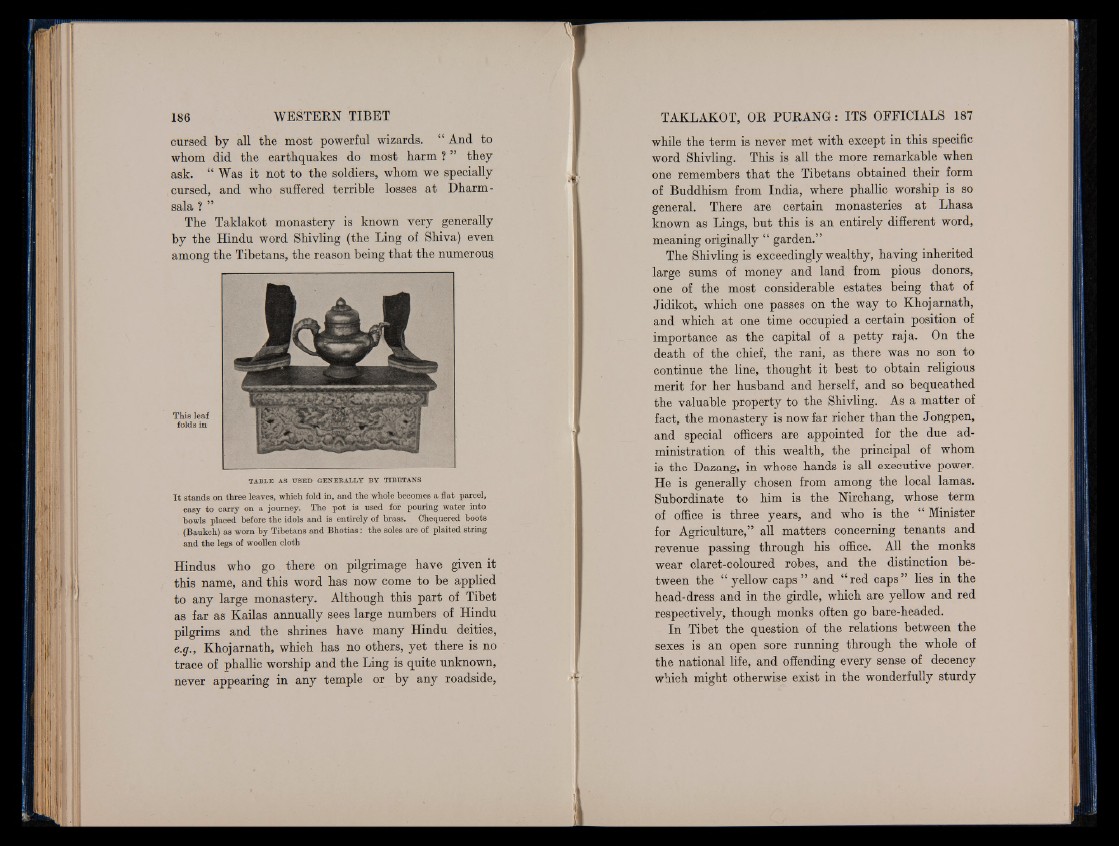
cursed by all the most powerful wizards. “ And to
whom did the earthquakes do most harm ? ” they
ask. “ Was it not to the soldiers, whom we specially
cursed, and who suffered terrible losses at Dharm-
sala ? ”
The Taklakot monastery is known very generally
by the Hindu word Shivling (the Ling of Shiva) even
among the Tibetans, the reason being that the numerous
This leaf
folds in
TABLE AS USED GENERALLY BY TIBETANS
I t stands on three leaves, which fold in, and the whole becomes a flat parcel,
easy to carry on a journey. The pot is used for pouring water into
bowls placed before the idols and is entirely of brass. Chequered boots
(Baukch) as worn by Tibetans and Bhotias: the soles are of plaited string
and the legs of woollen cloth
Hindus who go there on pilgrimage have given it
this name, and this word has now come to be applied
to any large monastery. Although this part of Tibet
as far as Kailas annually sees large numbers of Hindu
pilgrims and the shrines have many Hindu deities,
e.g., Khojarnath, which has no others, yet there is no
trace of phallic worship and the Ling is quite unknown,
never appearing in any temple or by any roadside,
while the term is never met with except in this specific
word Shivling. This is all the more remarkable when
one remembers that the Tibetans obtained their form
of Buddhism from India, where phallic worship is so
general. There are certain monasteries at Lhasa
known as Lings, but this is an entirely different word,
meaning originally “ garden.”
The Shivling is exceedingly wealthy, having inherited
large sums of money and land from pious donors,
one of the most considerable estates being that of
Jidikot, which one passes on the way to Khojarnath,
and which at one time occupied a certain position of
importance as the capital of a petty raja. On the
death of the chief, the rani, as there was no son to
continue the line, thought it best to obtain religious
merit for her husband and herself, and so bequeathed
the valuable property to the Shivling. As a matter of
fact, the monastery is now far richer than the Jongpen,
and special officers are appointed for the due administration
of this wealth, the principal of whom
is the Dazang, in whose hands is all executive power.
He is generally chosen from among the local lamas.
Subordinate to him is the Nirchang, whose term
of office is three years, and who is the “ Minister
for Agriculture,” all matters concerning tenants and
revenue passing through his office. All the monks
wear claret-coloured robes, and the distinction between
the “ yellow caps ” and “ red caps ” lies in the
head-dress and in the girdle, which are yellow and red
respectively, though monks often go bare-headed.
In Tibet the question of the relations between the
sexes is an open sore running through the whole of
the national life, and offending every sense of decency
which might otherwise exist in the wonderfully sturdy